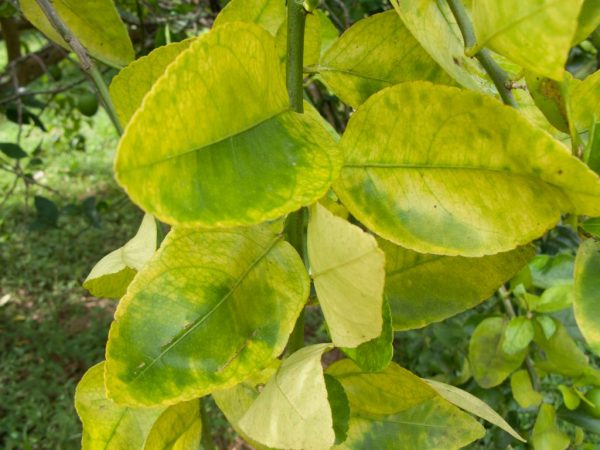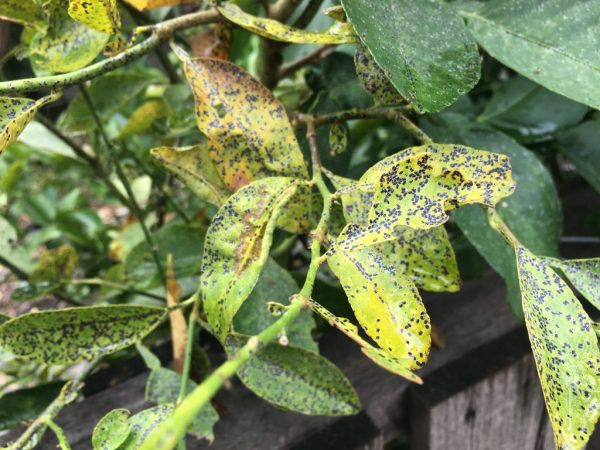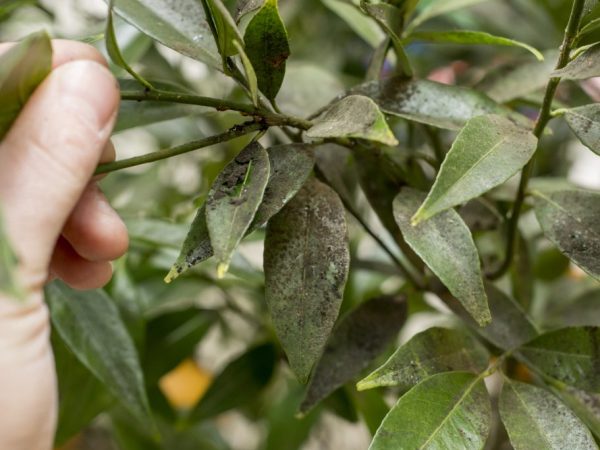Diseases and pests of indoor citrus
Diseases and pests of citrus fruits cause a lot of difficulties when growing indoor lemon, tangerine, calamondine and orange at home. This is often due to improper plant care.

Diseases and pests of indoor citrus
Lack of nutrition
The lack of nutrients necessary for citrus trees in the substrate (chlorosis) leads to a change in the appearance of plants:
- With an insufficient amount of nitrogen, the overall growth of the plant is inhibited, chlorosis occurs, which is expressed in the coverage of old citrus foliage with yellow specks, followed by the replacement of the color of the entire leaf blade and the loss of glossy shine. Shoots stop growing.
- Lack of potassium leads to the appearance of foliage between the veins and the formation of grooves in the foliage. The upper leaf layer twists towards the bottom, turns bronze at the edges and subsequently turns brown, dries, the development of citrus slows down, adult shoots die off, and young ones grow shorter. At the stage of flowering, the foliage falls off profusely, the fruits grow small, with a thin skin.
- With an insufficient amount of magnesium, chlorosis manifests itself on the tissues of the leaf blade parallel to the middle vein, gradually spreading in all directions.
- With a lack of phosphorus, citrus leaves fade, dry out at the end, turn yellow and subsequently acquire a rusty brown color, the newly emerging citrus leaves become smaller and grow narrow, the flowering stage is weak, the yield drops, the fruit forms a thick rind and increased acidity, the shape changes.
- Lack of iron and a small amount of manganese, sulfur and zinc manifests itself in the form of a contrasting mesh, consisting of green veins, leading to shrinking foliage and fruits. Newly grown shoots are weak, often fall off.
- A small amount of calcium leads to folding of the upper leaves by 1/3 of the length of the leaf blade with a bend along the central vein and subsequent death of the edges. After some time, the damaged castings fall off.
- Lack of boron disrupts the acid-base balance of the substrate and leads to wilting and subsequent shedding of the ovaries, citrus trees shed unripe fruits, young leaves turn yellow and curl, acquiring a light color and becoming covered with watery spots, become translucent.
In order to avoid a lack of nutrition for citrus trees, regular fertilizing of plants is carried out throughout the entire calendar year, with an interval of 10 days from March to September and once a month from October to February. As fertilizing complexes, they use ready-made mineral compositions or folk remedies - sources of the necessary elements.
Major citrus diseases
Home-grown citrus fruits infect several diseases caused by fungal, bacterial microorganisms and mycoplasmas.As a result, certain defects appear on the plants in the form of spotting, putrefactive foci, ulcers and growths.
The main distributors of infectious pathogens are insects and water used for irrigation and spraying.
Fungal and bacterial infections are treated with fungicides. Viral and mycoplasmic diseases are not treated, the affected plant is destroyed.
General measures for prevention and treatment:
- proper care,
- pruning of the affected vegetative parts, followed by disinfection of the cut sites with coal,
- removing buds, inflorescences and fruits from the affected plant as a method to support weakened citrus and redirect forces to restore and increase immunity,
- spraying with Bordeaux liquid with a concentration of 1%, the use of fungicidal preparations, for example, phytosporin.
Anthracnose
A common fungal disease is anthracnose, which affects all vegetative parts of citrus fruits and leads to the dropping of inflorescences, yellowing of foliage, the appearance of reddish spots on the fruits, and the death of shoots.
Control measures

Diseased shoots must be removed
To combat anthracnose, dead shoots are cut off. The plant is treated with fungicidal agents, providing further proper care for the plant.
Wart
Fungal wart affects young growths, foliage and fruits, while transparent yellow spots appear on the foliage, which eventually transform into pink-gray warts. Beardoves grow to a single growth of large size, leading in some cases to the death of the appendix. Under the influence of the fungus, the fruits become covered with orange spots, which eventually turn brown.
Control measures
At the initial signs of wartiness, the affected vegetative parts of the plant are cut off and burned. The rest of the crown is treated with Bordeaux liquid with a concentration of 1%, repeating the treatment once a month.
Gommoz
Hommosis, or gum flow, in citrus fruits manifests itself through longitudinal brown spots with a red tint on the stem and shoots. The affected bark dies off, and gum flows out of the resulting cracks - a sticky yellow-golden liquid that solidifies under the influence of air.
Control measures
For prophylaxis, the soil mixture is treated before planting with formalin with a solution concentration of 1%. In the course of treatment, the crack on the stem is disinfected with copper sulfate with a concentration of 3% and covered with garden varnish. The treatment is repeated until complete overgrowth.
Late blight
Late blight often affects plants grafted onto an orange. Young seedlings develop a ring-shaped, oily spot on the stem of a brown color. Fungal disease in external symptoms is similar to gommosis.
Control measures
Late blight is cured by treatment with copper sulfate.
Root rot
Root rot is accompanied by massive foliage loss.
Control measures
The damaged roots are cut off and treated with preparations that stimulate rooting. The substrate in the pot container is replaced with a new one. Provide adequate lighting and reduce watering.
Citrus pests

Aphids lead to wilting of the plant
When grown at home, plants are often the focus of insect pests.
Aphid
The common aphid is a frequent parasite that colonizes citrus plantings. Its appearance leads to the drying out of the foliage, curling its edges and wilting. Aphids are small, light green insects. It feeds on plant sap.
Root aphids attack citrus roots. She enters the home with an infected substrate.
Control measures
Insecticidal preparations and spraying with a decoction of garlic peels help to get rid of aphids during its mass distribution. As a preventive measure, complex fertilizers are used. The foliage affected by aphids is removed.
When root aphids appear, the plant is transplanted and treated with an insecticide.
Spider mite
When a spider mite appears, citrus foliage curls, insects weave a web around it. The parasite spreads due to insufficient humidity in the room.
Control measures
In the fight against spider mites, boric acid is used with a solution concentration of 1%. I repeat the spraying 1-5 times.
Shield
The scale insect enters the houseplant in the larval stage through infected material. As it grows older, it settles on the underside of the leaf. The pest feeds on plant juice, as a result of which the citrus weakens and is more often exposed to concomitant diseases.
Control measures
Spraying with garlic broth and insecticides helps against the scale insect.
Conclusion
In the process of home cultivation, citrus fruits often infect infectious and viral diseases. Indoor plants also attract insects. Measures taken against diseases and pests of citrus fruits help save indoor citrus.


